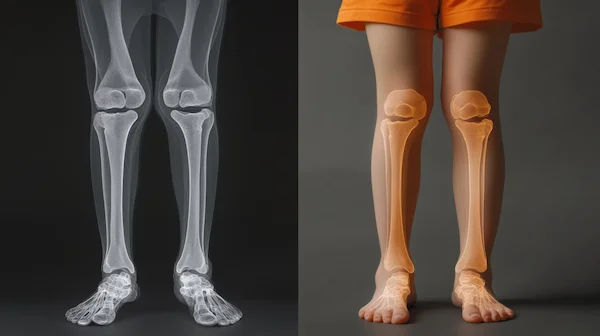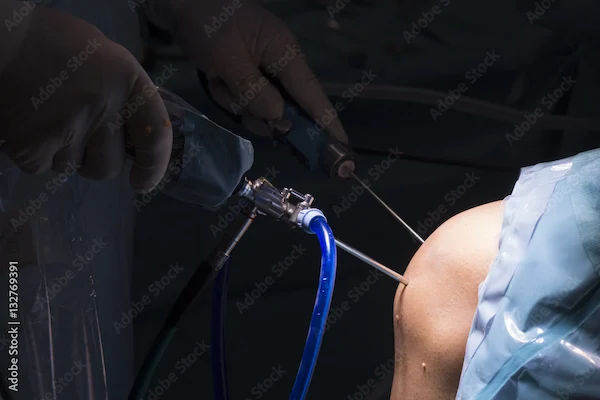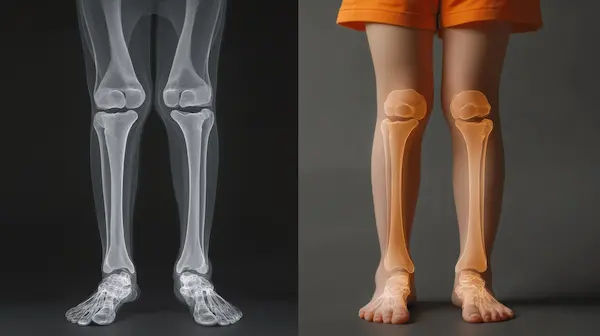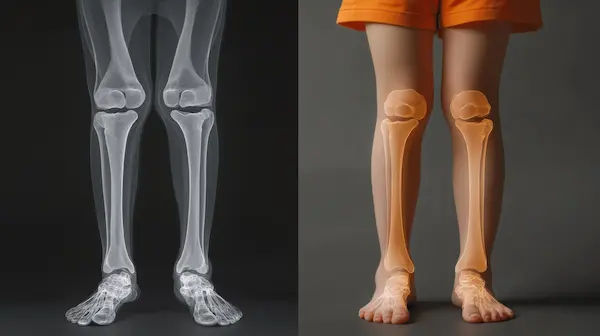Knock Knees: Causes, Symptoms, and Effective Treatments
Discover the causes, symptoms, and treatment options for knock knees (genu valgum). Learn how to distinguish normal growth from underlying issues and explore effective management strategies.

Written by
Last updated on 19th Sep, 2025
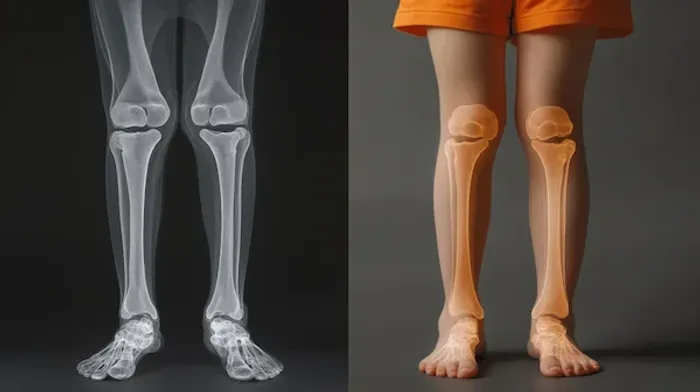
Introduction
Have you noticed your child's knees touching while their ankles remain apart? Or perhaps you’ve experienced knee pain yourself and observed this alignment in the mirror. This common postural trait is known as knock knees, or by its medical term, genu valgum. For many young children, it's a normal and temporary phase of growth that corrects itself. However, when it persists into adolescence or adulthood, or is caused by an underlying condition, it can lead to pain and mobility issues. This comprehensive guide will walk you through everything you need to know about knock knees—from distinguishing normal development from potential problems, to exploring the causes, symptoms, and the full range of treatment options available. Understanding this condition is the first step toward ensuring healthy leg development and finding relief.
What Exactly Are Knock Knees? (Genu Valgum)
The Simple Definition
Knock knees (genu valgum) is a condition where the knees angle inwards and touch each other when the legs are straightened, while the ankles remain separated. Imagine standing with your feet shoulder-width apart; if your knees are knocking together, you likely have a degree of genu valgum. It's easily identifiable by a gap of 3–4 inches or more between the ankles when the knees are touching.
Knock Knees vs. Bow Legs: Understanding the Difference
It's crucial to distinguish knock knees from its opposite condition, bow legs (genu varum). While knock knees involve knees touching and ankles apart, bow legs are characterised by an outward curvature, creating a space between the knees when the ankles are together. Both are common in infancy and childhood, but they follow different developmental timelines. Babies are often born bowlegged, which typically straightens out by age 2–3, followed by a period of knock knees that is most pronounced around age 4–5. This usually resolves naturally by age 7–8.
What Causes Knock Knees? The Common and The Uncommon
Physiological Genu Valgum (The Normal Kind)
The vast majority of knock knees cases in children are physiological. This means it's a normal part of growth and development. As a child grows, their bones undergo various changes in alignment. The slight knock-kneed appearance in pre-schoolers is a standard stage of skeletal maturation and requires no intervention other than routine check-ups to ensure it follows the expected pattern of correction.
Underlying Medical Conditions
In some cases, knock knees can be pathological, meaning it's caused by an underlying disease or condition. This is more likely if the condition is severe, asymmetric (one leg more than the other), appears suddenly, or persists beyond age 7–8.
Nutritional Deficiencies (Rickets)
A classic cause of pathological knock knees is rickets, a disease caused by a prolonged deficiency of vitamin D, calcium, or phosphate. These nutrients are essential for strong, hard bone formation. Without them, bones become soft and weak, leading to bending and deformities under the body's weight, including pronounced knock knees. With improved nutrition, rickets is less common but still occurs.
Genetic and Skeletal Conditions
Certain genetic conditions like skeletal dysplasias or metabolic bone diseases can affect growth plate development and lead to malalignment. Other causes include injuries to the growth plate around the knee, which can disrupt normal growth on one side, causing the leg to angle inwards.
Obesity and Injury
Excess body weight can place increased stress on a child's developing legs, potentially exacerbating knock knees or delaying their natural correction. In adults, knock knees can develop due to an injury (like a fractured bone that healed incorrectly), arthritis that wears down the knee cartilage on one side, or osteoporosis.
Consult a Specialist for Personalised Advice
Signs and Symptoms: When Should You Be Concerned?
Normal Appearance vs. Red Flags
A symmetrical, slight-to-moderate knock-kneed appearance in a child between ages 2 and 7 is usually not a cause for concern. Red flags that warrant a doctor's evaluation include:
The condition is severe and getting worse over time.
It affects only one leg.
It persists beyond age 8.
It is present in an adult with no previous history.
Associated Pain and Functional Issues
When knock knees are problematic, they can cause:
Knee, hip, or ankle pain: due to uneven stress on the joints.
A limp or awkward walking pattern (gait).
Difficulty running or participating in sports.
Knee instability or a feeling of the knee "giving way."
Foot pain or flat feet, as the alignment can affect the entire leg.
How Are Knock Knees Diagnosed?
The Physical Examination
A doctor, usually an orthopaedic specialist, will begin with a thorough physical exam. They will observe the child's walk, measure the distance between the ankles (intermalleolar distance), and assess leg alignment in various positions. They will also check for any associated pain and evaluate the range of motion in the hips, knees, and ankles.
The Role of Imaging (X-rays and Scans)
If the knock knees are severe, atypical, or persistent, the doctor may order weight-bearing X-rays of the legs. This provides a clear image of the bones and allows the doctor to measure the precise angle of the deformity. It also helps rule out other underlying bone diseases. In complex cases, a CT scan might be used for more detailed 3D planning, especially if surgery is being considered. If you're concerned about your child's leg alignment, consulting a doctor online with Apollo24|7 can provide an initial assessment and guidance on whether an in-person visit is needed.
Treatment Options for Knock Knees: From Watchful Waiting to Surgery
Observation and Monitoring (The Most Common "Treatment")
For physiological knock knees, the standard and most effective treatment is observation. Doctors will typically monitor the child's growth during annual check-ups to ensure the alignment is gradually self-correcting. No further action is needed if it's improving as expected.
Non-Surgical Interventions
Physical Therapy and Targeted Exercises
While exercises cannot change the bone alignment, they are incredibly valuable for managing symptoms. A physical therapist can design a programme to strengthen the hip abductors (especially the gluteus medius), quadriceps, and core muscles. This improved strength helps control the femur (thigh bone) and stabilise the knee, reducing pain and improving gait mechanics. This is a cornerstone of management for both children and adults with symptomatic knock knees.
Orthotics and Shoe Inserts
Shoe inserts (orthotics) or specialised shoes will not correct the bony deformity of knock knees. However, they can be useful if the person also has flat feet or foot pain. The orthotics provide arch support and help distribute pressure more evenly across the foot, which can alleviate discomfort in the feet, ankles, and knees caused by the malalignment.
Surgical Procedures for Severe Cases
Surgery is only considered in a small percentage of severe cases that cause significant pain, functional limitations, or are caused by a progressive underlying condition.
Guided Growth Surgery (Minimally Invasive)
This is a common, minimally invasive procedure for children and adolescents who are still growing. A small metal plate or screw (known as a tension band plate) is placed on the growth plate on the inside of the knee. This temporarily tethers that side of the growth plate, allowing the outside of the knee to continue growing and gradually straightening the leg over 6–18 months. Once corrected, the hardware is removed.
Osteotomy (Bone Realignment)
For adults or adolescents who have stopped growing, an osteotomy is the preferred surgical option. This involves making a precise cut in the bone (either the femur or tibia) and reshaping it to correct the alignment. The bone is held in its new position with plates and screws until it heals. This is a more significant surgery but can effectively reduce pain and prevent further joint damage, particularly from arthritis.
Can Exercises Help Correct Knock Knees?
For physiological knock knees in children, exercises are not necessary for correction as it is a natural process. However, for individuals of any age experiencing pain or instability, targeted exercises are vital for management. Focus on:
Hip Strengthening: Clamshells, side-lying leg raises, and banded walks target the glutes, which help pull the knee into a better alignment.
Quadriceps and Hamstring Strengthening: Straight leg raises and bridges support the knee joint.
Balance and Proprioception: Single-leg stands and balance board exercises improve the nervous system's ability to control leg position.
It's best to consult a physical therapist for a personalised exercise plan. If your condition does not improve after trying these methods, book a physical visit to a doctor with Apollo24|7 for further evaluation and a referral to a specialist.
Living with Knock Knees: Daily Management and Outlook
For most, knock knees are a transient childhood phase with an excellent outlook. For those with persistent symptoms, a focus on maintaining a healthy weight, staying active with low-impact exercises (swimming, cycling), and wearing supportive footwear can make a significant difference in managing discomfort. Regular follow-up with an orthopaedic doctor ensures that any progression is monitored and addressed appropriately.
Conclusion
Understanding knock knees is largely about understanding normal childhood development. While the sight of a child's knees touching can be worrying for a parent, it is most often a harmless, self-correcting stage. The key is to know the difference between typical physiological alignment and the signs that indicate a deeper issue, such as asymmetry, pain, or persistence beyond the expected age. If you or your child fall into the latter category, seeking professional medical advice is crucial. A healthcare provider can offer reassurance, diagnose any underlying conditions, and outline a clear management plan—from watchful waiting and physical therapy to surgical options for the most severe cases. Remember, you don't have to navigate this alone. Proactive consultation with an orthopaedic specialist can ensure optimal leg health and long-term mobility.
Consult a Specialist for Personalised Advice
Consult a Specialist for Personalised Advice

Dr. Avinash Pasuparthy
General Practitioner
5 Years • MBBS
Visakhapatnam
Apollo Clinic Vizag, Visakhapatnam

Dr Bhargav Vuppumalla
General Physician/ Internal Medicine Specialist
5 Years • MBBS MD GENERAL MEDICINE
Bengaluru
Apollo Medical Center, Marathahalli, Bengaluru

Dr. Ritesh Motghare
General Practitioner
18 Years • MBBS PGCDM
Nagpur
HEALTH CENTRE VNIT NAGPUR, Nagpur

Dr. Anand Ravi
General Physician
2 Years • MBBS
Bengaluru
PRESTIGE SHANTHINIKETAN - SOCIETY CLINIC, Bengaluru

Dr. Pankaj Tripathi
General Practitioner
20 Years • MBBS, MD Pathology
Lucknow
Best Diabetologist Clinic, Lucknow
More articles from Knock Knees
Frequently Asked Questions
Can knock knees be corrected in adults without surgery?
While surgery is the only way to physically change the bone alignment in adults, non-surgical methods are highly effective for managing symptoms. A consistent regimen of physical therapy to strengthen the hips and core, maintaining a healthy weight, and using supportive orthotics can significantly reduce pain and improve function, often making surgery unnecessary.
What are the best shoes for someone with knock knees?
Look for stable, supportive shoes with a firm heel counter and good arch support. Motion-control or stability running shoes can help manage the inward collapse (overpronation) that often accompanies knock knees. Avoid flimsy, unsupportive footwear like flip-flops or flat trainers.
Is there a specific knock knees exercise I can do at home?
A great starter exercise is the clamshell. Lie on your side with knees bent and stacked. Keeping your feet together, lift your top knee toward the ceiling without rocking your pelvis. This directly strengthens the gluteus medius, a key muscle for stabilising the hip and knee. Perform 2–3 sets of 15 repetitions on each side.
Can knock knees cause arthritis?
Yes, severe, uncorrected knock knees can alter the mechanics of the knee joint, placing excessive stress on the outer (lateral) compartment. Over many decades, this uneven load can accelerate the wear-and-tear process, leading to the development of osteoarthritis.
How much does knock knees surgery cost?
The cost of surgery for genu valgum varies widely based on geographic location, the hospital, the surgeon's fees, the type of procedure (guided growth vs. osteotomy), and insurance coverage. It can range significantly. A detailed cost estimate can only be provided by an orthopaedic surgeon after a consultation.
